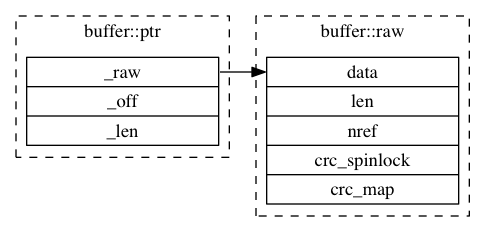前言
buffer list是ceph中的一个基础的数据结构,代码中大量的使用。
buffer::raw
介绍buffer list之前,我们必须先介绍buffer::raw和buffer::ptr。相对于buffer list,这两个数据结构相对比较容易理解。
class buffer::raw {
public:
char *data;
unsigned len;
atomic_t nref;
mutable simple_spinlock_t crc_spinlock;
map<pair<size_t, size_t>, pair<uint32_t, uint32_t> > crc_map;
...
}
注意,这个数据结构,data,len,nref,这些成员变量不难猜测出其含义,相信我们设计数据结构也会有这几个变量,data是个指针,指向真正的数据,而len记录了该buffer::raw数据区数据的长度,nref表示引用计数。
注意,data指针指向的数据可能有不同的来源,最容易想到的当然是malloc,其次我们以可以使用mmap通过创建匿名内存映射来分配空间,甚至我们可以通过pipe管道+splice实现零拷贝获取空间。有些时候,分配的空间时,会提出对齐的要求,比如按页对齐。
这是因为这些来源不同,要求不同,buffer::raw也就有了一些变体:
buffer:raw_malloc
这个变体数据来源源自malloc,因此,创建的时候,需要通过malloc分配长度为len的空间,,而不意外,析构的时候,会掉用free释放空间。
class buffer::raw_malloc : public buffer::raw {
public:
explicit raw_malloc(unsigned l) : raw(l) {
if (len) {
data = (char *)malloc(len);
if (!data)
throw bad_alloc();
} else {
data = 0;
}
inc_total_alloc(len);
inc_history_alloc(len);
bdout << "raw_malloc " << this << " alloc " << (void *)data << " " << l << " " << buffer::get_total_alloc() << bendl;
}
raw_malloc(unsigned l, char *b) : raw(b, l) {
inc_total_alloc(len);
bdout << "raw_malloc " << this << " alloc " << (void *)data << " " << l << " " << buffer::get_total_alloc() << bendl;
}
~raw_malloc() {
free(data);
dec_total_alloc(len);
bdout << "raw_malloc " << this << " free " << (void *)data << " " << buffer::get_total_alloc() << bendl;
}
raw* clone_empty() {
return new raw_malloc(len);
}
};
buffer::raw_mmap_pages
顾名思义,也能够猜到,这个数据的来源是通过mmap分配的匿名内存映射。因此析构的时候,毫不意外,掉用munmap解除映射,归还空间给系统。
class buffer::raw_mmap_pages : public buffer::raw {
public:
explicit raw_mmap_pages(unsigned l) : raw(l) {
data = (char*)::mmap(NULL, len, PROT_READ|PROT_WRITE, MAP_PRIVATE|MAP_ANON, -1, 0);
if (!data)
throw bad_alloc();
inc_total_alloc(len);
inc_history_alloc(len);
bdout << "raw_mmap " << this << " alloc " << (void *)data << " " << l << " " << buffer::get_total_alloc() << bendl;
}
~raw_mmap_pages() {
::munmap(data, len);
dec_total_alloc(len);
bdout << "raw_mmap " << this << " free " << (void *)data << " " << buffer::get_total_alloc() << bendl;
}
raw* clone_empty() {
return new raw_mmap_pages(len);
}
};
buffer::raw_posix_aligned
看名字也看出来了,对空间有对齐的要求。Linux下posix_memalign函数用来分配有对齐要求的内存空间。这种分配方式分配的空间,也是用free函数来释放,将空间归还给系统。
class buffer::raw_posix_aligned : public buffer::raw {
unsigned align;
public:
raw_posix_aligned(unsigned l, unsigned _align) : raw(l) {
align = _align;
assert((align >= sizeof(void *)) && (align & (align - 1)) == 0);
#ifdef DARWIN
data = (char *) valloc (len);
#else
data = 0;
int r = ::posix_memalign((void**)(void*)&data, align, len);
if (r)
throw bad_alloc();
#endif /* DARWIN */
if (!data)
throw bad_alloc();
inc_total_alloc(len);
inc_history_alloc(len);
bdout << "raw_posix_aligned " << this << " alloc " << (void *)data << " l=" << l << ", align=" << align << " total_alloc=" << buffer::get_total_alloc() << bendl;
}
~raw_posix_aligned() {
::free((void*)data);
dec_total_alloc(len);
bdout << "raw_posix_aligned " << this << " free " << (void *)data << " " << buffer::get_total_alloc() << bendl;
}
raw* clone_empty() {
return new raw_posix_aligned(len, align);
}
};
后面还有基于pipe和splice的零拷贝方式,我们不赘述。从上面的函数不难看出,buffer::raw系列,就像他的名字一样,真的是很原生,并没有太多的弯弯绕,就是利用系统提供的API来达到分配空间的目的。
buffer::ptr
buffer::ptr是在buffer::raw系列的基础上,这个类也别名bufferptr。
src/include/buffer_fwd.h
#ifndef BUFFER_FWD_H
#define BUFFER_FWD_H
namespace ceph {
namespace buffer {
class ptr;
class list;
class hash;
}
using bufferptr = buffer::ptr;
using bufferlist = buffer::list;
using bufferhash = buffer::hash;
}
#endif
这个类的成员变量如下,这个类是raw这个类的包装升级版本,它的_raw就是指向buffer::raw类型的变量。
class CEPH_BUFFER_API ptr {
raw *_raw;
unsigned _off, _len;
......
}

很多操作都是很容易想到的:
buffer::ptr& buffer::ptr::operator= (const ptr& p)
{
if (p._raw) {
p._raw->nref.inc();
bdout << "ptr " << this << " get " << _raw << bendl;
}
buffer::raw *raw = p._raw;
release();
if (raw) {
_raw = raw;
_off = p._off;
_len = p._len;
} else {
_off = _len = 0;
}
return *this;
}
buffer::raw *buffer::ptr::clone()
{
return _raw->clone();
}
void buffer::ptr::swap(ptr& other)
{
raw *r = _raw;
unsigned o = _off;
unsigned l = _len;
_raw = other._raw;
_off = other._off;
_len = other._len;
other._raw = r;
other._off = o;
other._len = l;
}
const char& buffer::ptr::operator[](unsigned n) const
{
assert(_raw);
assert(n < _len);
return _raw->get_data()[_off + n];
}
char& buffer::ptr::operator[](unsigned n)
{
assert(_raw);
assert(n < _len);
return _raw->get_data()[_off + n];
}
int buffer::ptr::cmp(const ptr& o) const
{
int l = _len < o._len ? _len : o._len;
if (l) {
int r = memcmp(c_str(), o.c_str(), l);
if (r)
return r;
}
if (_len < o._len)
return -1;
if (_len > o._len)
return 1;
return 0;
}
bufferlist
bufferlist才是我们的目的地,前两个类其实是比较容易理解的,但是bufferlist相对复杂一点。
bufferlist是buffer::list的别名:
#ifndef BUFFER_FWD_H
#define BUFFER_FWD_H
namespace ceph {
namespace buffer {
class ptr;
class list;
class hash;
}
using bufferptr = buffer::ptr;
using bufferlist = buffer::list;
using bufferhash = buffer::hash;
}
#endif
class CEPH_BUFFER_API list {
// my private bits
std::list<ptr> _buffers;
unsigned _len;
unsigned _memcopy_count; //the total of memcopy using rebuild().
ptr append_buffer; // where i put small appends

多个bufferptr形成一个list,这就是bufferlist。成员变量并无太多难以理解的地方,比较绕的是bufferlist的迭代器 ,理解迭代器,就不难理解bufferlist各个操作函数。
要理解bufferlist 迭代器,,首先需要理解迭代器成员变量的含义。
bl_t* bl;
list_t* ls; // meh.. just here to avoid an extra pointer dereference..
unsigned off; // in bl
list_iter_t p;
unsigned p_off; // in *p
- bl:指针,指向bufferlist
- ls:指针,指向bufferlist的成员 _buffers
- p: 类型是std::list
::iterator,用来迭代遍历bufferlist中的bufferptr - p_off : 当前位置在对应的bufferptr的偏移量
- off: 如果将整个bufferlist看成一个buffer::raw,当前位置在整个bufferlist的偏移量
这个递进关系比较明显,从宏观的bufferlist,递进到内部的某个bufferptr,再递进到bufferptr内部raw数据区的某个偏移位置。 此外还包含了当前位置在整个bufferlist的偏移量off。
注意p_off和off容易产生误解,请阅读seek函数仔细揣摩
seek(unsigned o),顾名思义就是将位置移到o处,当然o指的是整个bufferlist的o处。ceph实现了一个更通用的advance,接受一个int型的入参。
如果o>0,表示向后移动,如果o小于0,表示想前移动。移动的过程中可能越过当前的bufferptr之指向的数据区。
template<bool is_const>
void buffer::list::iterator_impl<is_const>::advance(int o)
{
//cout << this << " advance " << o << " from " << off << " (p_off " << p_off << " in " << p->length() << ")" << std::endl;
if (o > 0) {
p_off += o;
while (p_off > 0) {
if (p == ls->end())
throw end_of_buffer();
if (p_off >= p->length()) {
// skip this buffer
p_off -= p->length();
p++;
} else {
// somewhere in this buffer!
break;
}
}
off += o;
return;
}
while (o < 0) {
if (p_off) {
unsigned d = -o;
if (d > p_off)
d = p_off;
p_off -= d;
off -= d;
o += d;
} else if (off > 0) {
assert(p != ls->begin());
p--;
p_off = p->length();
} else {
throw end_of_buffer();
}
}
}
template<bool is_const>
void buffer::list::iterator_impl<is_const>::seek(unsigned o)
{
p = ls->begin();
off = p_off = 0;
advance(o);
}
除此以外,获取当前位置的ptr也很有意思,理解该函数也有帮助理解迭代器五个成员的含义。
template<bool is_const>
buffer::ptr buffer::list::iterator_impl<is_const>::get_current_ptr() const
{
if (p == ls->end())
throw end_of_buffer();
return ptr(*p, p_off, p->length() - p_off);
}
相当于多个bufferptr对应的buffer::raw组成了一个可能不连续的buffer列表,因此使用起来可能不方便,ceph处于这种考虑,提供了rebuild的函数。该函数的作用是,干脆创建一个buffer::raw,来提供同样的空间和内容。
void buffer::list::rebuild()
{
if (_len == 0) {
_buffers.clear();
return;
}
ptr nb;
if ((_len & ~CEPH_PAGE_MASK) == 0)
nb = buffer::create_page_aligned(_len);
else
nb = buffer::create(_len);
rebuild(nb);
}
void buffer::list::rebuild(ptr& nb)
{
unsigned pos = 0;
for (std::list<ptr>::iterator it = _buffers.begin();
it != _buffers.end();
++it) {
nb.copy_in(pos, it->length(), it->c_str(), false);
pos += it->length();
}
_memcopy_count += pos;
_buffers.clear();
if (nb.length())
_buffers.push_back(nb);
invalidate_crc();
last_p = begin();
}
从下面测试代码中不难看出rebuild的含义,就是划零为整,重建一个buffer::raw来提供空间
{
bufferlist bl;
const std::string str(CEPH_PAGE_SIZE, 'X');
bl.append(str.c_str(), str.size());
bl.append(str.c_str(), str.size());
EXPECT_EQ((unsigned)2, bl.buffers().size());
bl.rebuild();
EXPECT_EQ((unsigned)1, bl.buffers().size());
}
理解了上述的内容,bufferlist剩余的上千行代码,基本也就变成了流水账了,不难理解了,在此就不再赘述了。